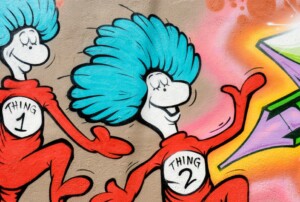
If you’ve read anything about storytelling on the internet in recent years, you’re likely to have come across this:
“Customers don’t generally care about your story; they care about their own.” (Donald Miller, Building a StoryBrand: Clarify Your Message So Customers Will Listen)
A bold statement.
Also, a statement often taken out of context. (Donald Miller is talking about branding here, not about storytelling.)
As Anna Bradshaw’s article about storytelling in e-commerce shows, “if you’re producing a high-quality product, using provenance in your marketing copy could allow you to charge twice as much” — suggesting that customers do indeed care about your story. And academic research has your back.
But how do you get started when you’re new to storytelling? If you’re (figuratively) dying to tell the world how you started your company, read on.
Step 1: Find Your What If…?
Still worried about the Donald Miller quote above — that people don’t care about your story?
Well, here’s the thing:
It doesn’t really matter whether “customers generally don’t care about your story”. That’s to be expected. After all, they don’t even know you, or why they should care.
Your job is to make them care.
And that’s the true power of a good story, even if it’s about yourself.
Here’s how storytelling expert Marsha Shandur explains how to make them care:
“Whether it’s your business, passionate hobby or worthy cause, tell the story of it in a way that shows us why it’s important to you. … Show some vulnerability. This doesn’t have to mean pouring out your innermost turmoiled diary thoughts (you can totally save those for your therapist). Just give us enough to know that you’re human.”
Jody Aberdeen’s article here on Change Creator explains why that approach will hit a nerve with your audience:
“In an age of outrage culture and sensational news media, we are inundated in everything that we don’t want the world to be and have. What people are craving more than anything in 2019 is something, maybe someone, to root for, not rail against. Make sure to show your audiences, through your storytelling, the world that you want to create and invite them to create it with you.”
That’s the power of the humble “What if…”: the power to “invite the imagination into a story we want to explore.” Which is why the What If is usually the first thing the Pixar team come up with when they create a new story:
To give you some What-If examples:
-
This podcast with SheEO founder & entrepreneur Vicky Saunders quite literally begins with her What-if statement.
-
Ethical Brand Marketing focus on visionary leaders working to save animals and the planet. Founder Jessica Lohmann’s What-If is simple: “What if we lived in a world of healthy choices and opportunities for all animals, humans included?”
-
Here’s how the fully transparent apparel brand Where Does It Come From? describe their What If: “What if we lived in a world where nurture after our planet and the life on it, producing just what we need and ensuring that it is created with kindness to people and planet and as part of a circular economy?”
What’s great about these examples is how closely tied they are to the daily work of the change creators. In the next step, we’ll form the same kind of bond between what you do and your vision.
Step 2: Take Us On the Road Towards Your What If
Now it’s time to list all the things you do in order to make your What If a reality.
This is a great exercise for a team brainstorming session. Mindmapping, journaling or recording voice memos whenever you can think of something new can also be useful.
However you decide to tackle this step, Anna Bradshaw’s list of questions is a great place to start:
-
“What’s the unique personal story that led you to develop this product?
-
How is this product manufactured?
-
Is it made with special equipment, in a special place, or stored in a certain way?
-
Where do the materials come from? Are they all from the same area? Are the ingredients organic?
-
Have you or your suppliers implemented more sustainable practices that set you apart in your industry?
-
Where do you get your inspiration and ideas for small design details and color palette?
-
Who actually manufactures your goods? Do you have a special group of product testers?”
Answering questions like these will make sure there’s a perfect fit between your vision, the way you run your business and the offer you make to your audience.
Swimwear brand Deakin and Blue‘s story is a particularly effective example of this.
It starts with the founder’s personal experiences, takes us on the road to her realizing her What If (What if there was swimwear with both style and substance?) and invites us to get involved at the end:
“Join our Revolution.
Over 500 women have already told us that our swimsuits have changed the way they feel about their bodies.
And we’re just getting started.”
Step 3: Plot a Story Arc onto Your Roadmap
At this point, you’ve got all the data to talk about your vision, how you’ll reach it and the impact you’re making.
The important thing now is to continue working on your story.
One of the most common mistakes I see impact businesses make is to stop here and declare a collection of facts their “story”. But until you’ve got that story arc in place, it’s really just a bunch of claims and numbers.
A clear beginning, middle, and end let the audience perk up, take notice and get involved emotionally.
In his seminal book Into the Woods, John Yorke (who’s behind UK drama favorites such as Shameless, Casualty, and Life on Mars) suggests a five-act story structure. It “creates gripping turning points that increase narrative tension and in turn eliminates one of the most common problems” less experienced storytellers struggle with: “the ‘sagging’, disjointed, confused and often hard-to-follow” middle of the story.
Importantly, when you develop your story, be brave and talk about some of the challenges you faced. What went wrong? How did you overcome the (inevitable) bumps in the road? Too few companies do this, although it makes your story so much more compelling. If you’re concerned about greenwashing or “social-washing”, then working your challenges into your story can be an effective way to stay real.
Example time! Let’s look at the structure of Cuddle & Kind‘s brand story:
Act 1: Call to adventure:
What If… we could help feed children in need? (Inspired by watching a documentary on childhood hunger)
Act 2: Response to the call:
Son Ethan suggests doing something about it — idea is to create sustainably hand-knit dolls and provide 10 free meals for each doll sold
Act 3: Midpoint: things get even more exciting, as they’re now in the thick of it. Going back is just as hard as carrying on:
Crowdfunding campaign
Act 4: Challenges — perhaps even a crisis point:
This is the weakest point in the video. Potential challenges that could make this story even more engaging could be the anxious first hours of their crowdfunding campaign, hearing about new areas where children need their support, or perhaps even the question of whether they’ll be able to attract enough revenue to be able to reach their vision
Act 5: Winning the (internal) battle:
Being able to give 4.2 million meals in just 3 years!
Step 4: Bring Your Story Arc to Life
Journalists, screenwriters and novelists have always known that an “honest story of someone going through the struggles of starting a business can be a great way to connect with your audience” (source).
One of the best ways to foster that connection is by using action scenes.
Choose at least one moment in your story that you can tell as if it were a film: show what the characters in your story are doing, describe what the place looks like and share how that situation feels.
The BBC’s take on the launch story of Bristol Cloth is a nice example. We get to see the place where Bristol Cloth is made, we can observe the production process. The imagery is so rich that we can almost smell the landscape and feel the texture of the cloth:
From the music to the imagery and the interview, it feels thoroughly authentic. According to the Ultimate Change Creator Guide to Creating a Brand Story, those are the precise ingredients that “help customers develop a sense of loyalty … that lasts for a long time”.
It’s perhaps easiest to do this in a video, but comic strips, news features and novels are all great sources for inspiration if you’re looking to work mainly with words and static images.
Step 5: Practice Telling Your Story
Congratulations! Your story is ready to be shared with the world.
If you don’t yet feel confident about it, don’t worry: that’s completely normal. Just go ahead and tell your story as often as you can, and in as many different ways as possible:
-
Face to face when you meet someone new
-
In a Facebook post
-
In an Instagram story
-
In a tweet
-
In a blog post
-
In a pitch desk to wholesalers, clients or investors
-
On your LinkedIn profile
-
On TV, on podcasts, on the radio or in magazines…
Over time, you’ll grow into your story, and your story will develop a life of its own. And remember, there’s a whole Change Creator Community waiting to dive into your story, too!
You might also like:










